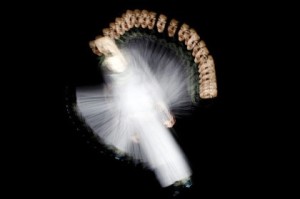Dance of the Spirit
Posted by Deirdre | Filed under Blog
There are primarily two schools of movement feeding the genre of avant-garde dance proliferating around the world – Butoh, the national art form of modern-day Japan, and Tanztheatre, or dance-theatre, the leading cultural export of modern-day West Germany. Karas, the Tokyo-based company led by award-winning Japanese choreographer and dancer Saburo Teshigawara, is a synthesis of both.
Ishi-No Hana (Flower of Stone) combines the “dark soul dancing” of Butoh with the expressionism of Tanztheatre. The result is an amazing theatrical creation with an abundance of striking visual imagery and a strong mystical cast.
A highly regarded dance and theatre artist in his native land, Teshigawara has put a new face on Japanese dance. His early training was in the visual arts, sculpture in particular. This is evident in his choreography, as he remains a sculptor in spirit, carving movement out of space. He studied mime and classical dance, but never Butoh or neo-expressionist dance-theatre, as his unique style may suggest. He has said of himself that he fuses past and future in an attempt to address “the vastness of now.”
His dance is concerned with the fleetingness of the moment. He sees change in all things. In his hands dance operates as a vehicle for self-metamorphosis. By becoming like all things he is all things. White from the tips of his bleached hair and his powdered face to his sock-like shoes, Teshigawara is a canvas on which can be drawn a thousand images.
His body seems boneless in motion, his neck, arms, legs and torso weightless. He looks like a cloud floating on the wind, a great heron gliding on its wings, a piece of paper swirling in a gust of fluid motion. He steps on shards of broken glass, crushing them with his hands and his knees, and in this way simulates moonbeams penetrating his body.
The images in Ishi-No-Hana are dream-like, fusing the surreal with the real. A geisha in a scarlet kimono undulates beside a girl-dragonfly. A pair of bicyclists pedal by a woman-chrysalis. There is no rationale for the way these images are assembled. Their randomness and transitoriness suggest they are following a dream-logic. There are no rules, only experience. The experience in the piece is the experience of the choreographer (the stylistic mix is clearly autobiographical), but also the experience of Japan.
Images of black skirted warrior-men, folk song, kimonos and butterflies are the tea leaves of a national culture afloat in Teshigawara’s new Japanese dance.
Helping Teshigawara sculpt his images on stage are dancers Kei Miyata (she founded Karas with Teshigawara five years ago), Sayoko Yamaguschi, Kaoru Omori, Shun Ito, Koichi Ienaga and Kiyoto Ito. Disciplined and controlled, they are completely in service to Teshigawara’s dream-vision. They appear to have no personalities of their own and no emotional stake in what they are doing. Their faces are stiff and blank. Any emotion registered seems painted on, much like the smiling or frowning faces of wooden puppets. This expressionlessness is intentional.
The experience of watching a work like Ishi-No-Hana is immensely rewarding. It stimulates the eye as it provokes the brain, inspiring wonder for a choreographer who can invent a new dance language while lending his voice to a timeworn theme, the meaning of life.

